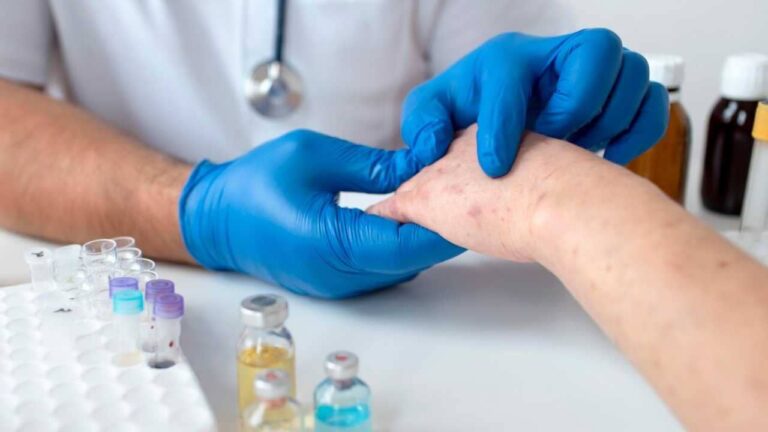Kaposi’s sarcoma is a type of cancer that was first identified by the Hungarian dermatologist Moritz Kaposi in 1872. It is a rare cancer that causes lesions to develop on the skin, mucous membranes, and internal organs.
Kaposi’s sarcoma is most commonly associated with HIV infection, but it can also occur in people with weakened immune systems or in people who have undergone organ transplants.
The lesions associated with Kaposi’s sarcoma are usually red, purple, or brown in color and can be flat or raised. They can occur anywhere on the body, but are most commonly found on the legs, face, and genital area. The lesions are caused by the growth of abnormal blood vessels and the accumulation of immune cells in the affected tissues.
Kaposi’s sarcoma is caused by infection with the Kaposi’s sarcoma-associated herpesvirus (KSHV), also known as human herpesvirus 8 (HHV-8). This virus is a member of the herpesvirus family, which also includes herpes simplex virus (HSV), varicella-zoster virus (VZV), and cytomegalovirus (CMV).
The exact mechanisms by which KSHV causes Kaposi’s sarcoma are not fully understood, but it is believed to involve a complex interaction between the virus and the immune system. KSHV can infect a variety of cells in the body, including immune cells and endothelial cells (the cells that line blood vessels).
In people with weakened immune systems, such as those with HIV infection or those who have undergone organ transplants, the virus can cause uncontrolled growth of these cells, leading to the formation of tumors.
There are several different types of Kaposi’s sarcoma, including classic, endemic, iatrogenic, and epidemic (associated with HIV infection). Classic Kaposi’s sarcoma is most commonly found in elderly men of Mediterranean or Jewish descent, and is generally limited to the skin.
Endemic Kaposi’s sarcoma is found primarily in sub-Saharan Africa and is associated with infection with KSHV and other viruses such as Epstein-Barr virus (EBV) and hepatitis B virus (HBV). Iatrogenic Kaposi’s sarcoma occurs in people who have undergone organ transplants or who are taking immunosuppressive drugs for other medical conditions.
Epidemic Kaposi’s sarcoma is most commonly associated with HIV infection and can occur in people with CD4 counts below 200 cells/mm3.
The diagnosis of Kaposi’s sarcoma is usually made by biopsy of the affected tissue. Treatment options for Kaposi’s sarcoma depend on the type and extent of the disease, as well as the underlying cause.
In some cases, the lesions may be monitored without treatment if they are not causing significant symptoms or if the immune system is able to control the growth of the tumors. In other cases, treatment may include antiviral drugs such as ganciclovir or foscarnet, chemotherapy, or radiation therapy.
In people with HIV infection, the most effective treatment for Kaposi’s sarcoma is the use of antiretroviral therapy (ART) to suppress the replication of the virus and restore immune function. ART can also help to prevent the development of other HIV-related illnesses.
Prevention of Kaposi’s sarcoma involves avoiding infection with KSHV and other viruses that are associated with the disease. This may include practicing safe sex, avoiding sharing needles or other drug paraphernalia, and avoiding contact with blood or bodily fluids from an infected person.
In conclusion, Kaposi’s sarcoma is a rare cancer that is most commonly associated with HIV infection, but can also occur in people with weakened immune




